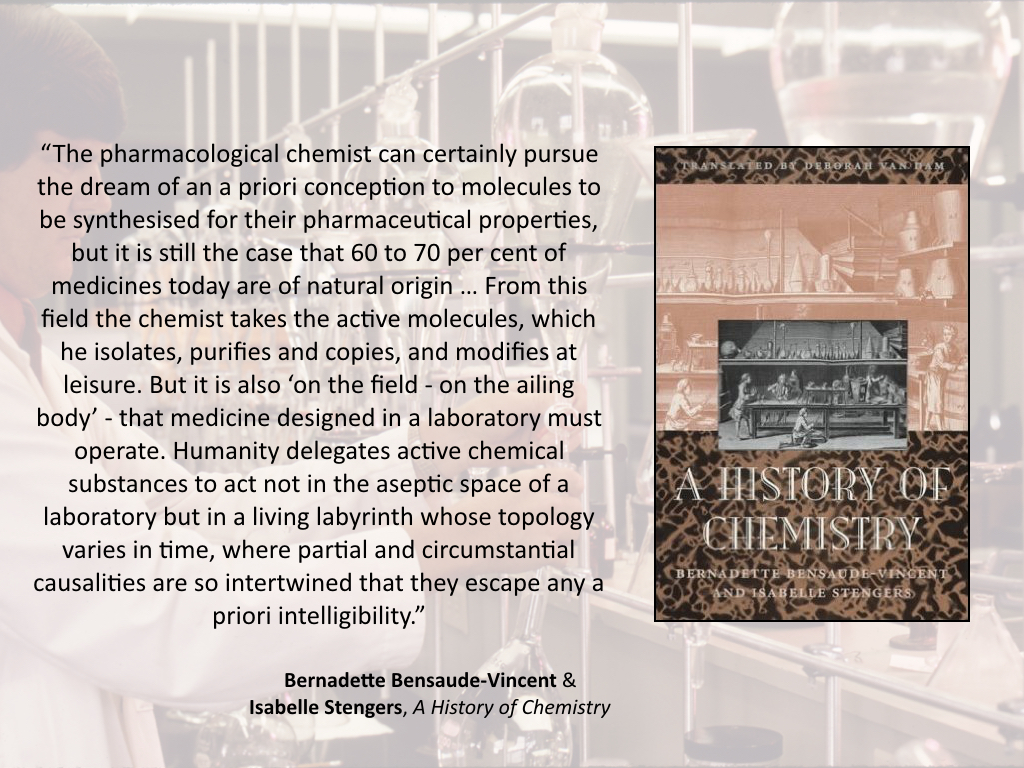|
Now that the bulk of lecture writing for the year is over, my commute to London becomes a little less frantic. I swap the Keynote software for the iPad and finally delve into some of the books and papers that I have been stockpiling over the past couple of months. My "to read" list is very long, but I triage the readings according to projects that I am working on at the moment - I find it best to read only those articles or books that are directly relevant to my current writing and research.
It was great, then, to turn to a book that has long been on my shelf: Bernadette Bensaude-Vincent and Isabelle Stengers' A History of Chemistry (Harvard, 1996). Here is the description from the publisher: From the earliest use of fire to forge iron tools to the medieval alchemists’ search for the philosopher’s stone, the secrets of the elements have been pursued by human civilization. But, as the authors of this concise history remind us, “disciplines like physics and chemistry have not existed since the beginning of time; they have been built up little by little, and that does not happen without difficulties.” Bernadette Bensaude-Vincent and Isabelle Stengers present chemistry as a science in search of an identity, or rather as a science whose identity has changed in response to its relation to society and to other disciplines. The authors—respected, prolific scholars in history and philosophy of science—have distilled their knowledge into an accessible work, free of jargon. They have written a book deeply enthusiastic about the conceptual, experimental, and technological complexities and challenges with which chemists have grappled over many centuries. Beginning with chemistry’s polymorphous beginnings, featuring many independent discoveries all over the globe, the narrative then moves to a discussion of chemistry’s niche in the eighteenth-century notion of Natural Philosophy and on to its nineteenth-century days as an exemplar of science as a means of reaching positive knowledge. The authors also address contentious issues of concern to contemporary scientists: whether chemistry has become a service science; whether its status has “declined” because its value lies in assisting the leading-edge research activities of molecular geneticists and materials scientists; or whether it is redefining its agenda. A History of Chemistry treats chemistry as a study whose subject matter, the nature and behavior of qualitatively different materials, remains constant, while the methods and disciplinary boundaries of the science constantly shift. I was drawn to the book because of the connections between chemistry and the pharmaceutical industry (expanded upon by Andrew Barry and others). I'm particularly interested in the scientific-social-economic relations through which chemicals emerge. Bensaude-Vincent and Stengers suggest that matter that emerges through the research and development process is transformed into "informed material" that is rich in information and saturated by relations (in the laboratory and beyond). I've taken lots of notes here that will be relevant for my second year course on biomedicine - I will be expanding and re-writing this next year - so hopefully there will be some space to delve into the laboratory with my class. In particular, I think the slide below will feature somewhere:
0 Comments
Leave a Reply. |
Archives
April 2023
Categories |

 RSS Feed
RSS Feed